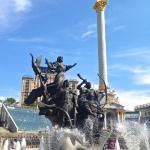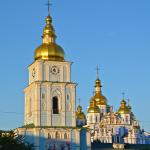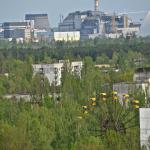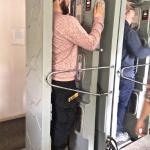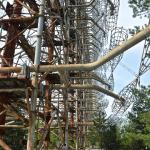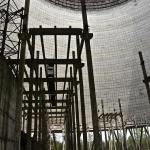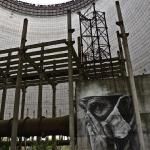© 2011 Sabrina Swenson. All Rights Reserved.
Chernobyl
May, 2016
Chernobyl. The site of the world's worst nuclear power plant accident in history, catastrophic in nature. I remember the day well. It was April 26, 1986 and I was a senior in high school. Government and Sociology teacher Mr. Otte came into the classroom and asked if anyone knew what had happened that day. In my small, childhood town in Iowa, we had no idea. I had never heard of Chernobyl in the then Ukrainian Soviet Socialist Republic of the Soviet Union. It seemed as far away as the moon. Who knew 30 years later I would visit the site.
A visit to Chernobyl, located in present day Ukraine, Eastern Europe, takes a bit of planning. You are simply not allowed to just wander into the area on your own. You must sign up for a tour a minimum of ten days in advance, which is required due to a mandatory background check. I couldn't imagine why a background check was necessary, however, found out later that apparently if you're looking to build a dirty bomb, Chernobyl would have the radioactive material necessary. Having seen the place, however, I can't imagine how you could ever get close enough to swipe some. I was given authorization for the tour a few days later and shortly thereafter was on a flight headed to Kiev, the capital of Ukraine. I caught the train into the city center where Independence Square resides and couldn't believe how beautiful it was. It took me by surprise as having been to numerous post-Soviet states, I had low expectations for the beauty of the place. Most, with their ugly Soviet block style buildings were eye sores. Kiev, however, delighted. It had beautiful statues and fountains, a gold onion-domed church that was simply magnificent and a street fest carried on with live music and street food. It was also very inexpensive. With the current conflict over the Crimea region between Ukraine and big brother Russia, both wanting the gorgeous island of land in Ukraines South for their own, the economy is not doing well. I picked a hotel right at Independence Square as this is where we were to meet the following morning. I had some street food, listened to some music and called it a night.
Early the next morning I stepped out of my hotel. Dressed in the required long pants and long sleeve shirt, closed shoes and with strict instructions not to touch anything at Chernobyl, I headed to the pick up point. My only directions where to meet in front of a certain hotel on the square. I showed up to find two young Finish guys milling about and discovered they were headed to Chernobyl as well. Eventually there were more 20-something Finish, English and Welch guys who arrived all awaiting the trip. There were eight guys in total and me, the only women and at least a few decades older. I wondered why in the world these young men had a fascination with an event that happened before they were even born. Our guide showed up and he too, was in his 20's. We had roll call and he then proceeded to hand out geiger counters. Geiger counters are used for measuring ionizing radiation. In wide use it's used as a hand-held radiation survey instrument. With our new toys in hand, we climbed into the van and headed North. On the 85 mile, two hour drive we watched a documentary on the disaster that happened on that Spring day, so many years before.
We pulled up to a huge military check point that marked the entry to the Chernobyl area. Security was strict and no one was allowed through without the proper paperwork. We all had to get out of the van and wait some time while our guide had us processed. We were eventually cleared and drove on through checkpoint Dytiatky and into the Chernobyl exclusion zone.
We arrived into the town of Pripyat, which was built specifically to serve the workers of the nuclear power plant. Located under two miles from the plant, at the time of the disaster, it's population was over 49,000. If ever there was a ghost town, Pripyat is it. We got out of the bus and started to walk the empty, apocalyptic-looking streets. Hastily abandoned buildings are now in ruins after years of total neglect. Many windows are broken out allowing the elements in. Paint is chipping and the foliage has run amuck. After the disaster all trees and bushes were bulldozed, however 30 years later Mother Nature has prevailed and grown back full, green and lush. While taking in this hard-to-believe scene, our guide told us that in recent years some of Pripyat's buildings had started to collapse. We were standing directly in front of one as he stated the government now officially bans all entry to the buildings of Pripyat. But, he said, we'd be going in anyway! We entered our first building, that of an apartment and climbed the first of many staircases. Obviously, with no power in the city, no elevators were working. As such, we headed up the first of numerous flights, stopping periodically to peer into many of the apartments, which were once someones home. All the apartment buildings we entered had rooftops that were accessible and upon reaching the top, you were able to see how close the nuclear power plant was to Pripyat.
We headed into a gymnasium at one point and saw a large, empty pool and basketball court. We headed into a kindergarten which was complete with small beds for afternoon naps. Some dolls, their clothes now in rags, had been left on the beds. A hospital we went to had rooms, each identifiable by the items that were left behind. In one room, a gynecologist chair with stirrups sat. In another room, a row of empty, now rusting nursery baby bassinets remained. Building after building there were abandoned chairs, desks and papers often strewn about the rooms. One room in a school had the floor littered with gas masks, apparently left over from the threat of American missiles during the Cold War. Although most buildings had plenty of light, as it was a sunny day, some, like the local jail were totally dark. I walked in and immediately felt the temperature drop. It was completely black inside. I grabbed my flashlight and got a first hand look at former Soviet jail cells. They were quite miserable. Small, dark and dank, there was heavy moisture in the air. They had one small window and not much else. The cells lined both sides of the hallway and I was happy to exit that particular building.
We had our geiger counters with us at all times and usually the reading was normal. Generally up to a .06 microSieverts reading is considered naturally occurring in nature. Many items in nature emit some radiation such as marble countertops. We checked our geiger counters before leaving Kiev and had a reading around .06. Most of Pripyat was at or under this level, however, every once in a while the counter would fly off the charts and start a piercing alarm indicating unsafe levels of radiation were present. This happened once while in the hospital. Our guide showed us how most of the hospital was at safe levels, however, when he moved the counter near a discarded first responders head cover, the one used under their helmet, the counter began screaming. When we checked the level, it was 27.5! Way beyond what is considered safe. Thirty years later and this first responder fire fighters head cover was still highly contaminated.
We eventually ended up at the Pripyat amusement park complete with a ferris wheel and bumper cars. All were rusty and covered with foliage. As we walked past the ferris wheel a gigantic structure came into view completely dwarfing us in size. It was the largest antenna I'd ever seen. At almost 500 feet high and 1,640 feet wide, Duga, it's official name, aka the Russian Woodpecker, was the Soviet military radar system used as part of the anti-ballistic missile early-warning network. Basically Moscow's hidden eye used to spot incoming American missiles during the Cold War. The signal Duga made could be heard on short-wave radio bands worldwide from 1976 to 1989 and sounded like a sharp repetitive tapping noise hence the woodpecker dub. America would have loved to have known where this baby was during the Cold War! The guide let us climb this huge mesh of steel, but, only up to the 4th level as he didn't want the guards to see us. Apparently climbing Duga is not allowed. It seemed our young guide was not really into following rules.
As we found our way back to the streets of Pripyat our guide told us of the exact events of the day reactor number 4 exploded. The cause of the explosion was human error and violation of procedures. After the security system had been deactivated, a test began. The unsafe reactor design caused instability at low power. When the unscheduled and impromptu test was conducted at low power, the reactor became critical. It was followed by an enormous explosion of the reactor core that blasted the 1,200 ton cover of the reactor into the air. From the hole, a spray of fire charged with radioactive particles infusion, shot over 3,000 feet into the sky contaminating the area. First responder firefighters headed to the reactor to spray it with water to no avail. At the bottom of the destroyed reactor 1,200 tons of white hot magma continued to burn at over 3,000 degrees sending out radiative gas and dust into the atmosphere. Eventually helicopters were dispatched over the reactor to drop 175 pound sandbags into the blaze. Using their bare hands they dropped the bags of sand and boric acid, which neutralizes radiation. Six thousand tons of sand and boric acid were dumped on the reactor. At the bottom, 195 tons of nuclear fuel were still burning, giving off incredible heat that was gradually melting the sand. On the surface of the plug, cracks began to appear. Once the hole had been plugged, the temperature began to rise. They were afraid the critical temperature could be reached and set off a second explosion. A cement slab beneath the reactor core was heating up and endanger of cracking. Magma was threatening to seep through. The water the fireman poured on the first hours of the disaster had pooled below the slab. If the radioactive magma had made contact with the water, it would have set off a second explosion more devastating than the first. It would have been comparable to an atomic bomb 10 times more powerful than Hiroshima, rendering Europe uninhabitable. Interestingly, this fact was kept from the public for 20 years! At this point they sent in firemen to drain the reactor and seal the breach more effectively. After this they dropped 2,400 tons of lead into the reactor. The temperature went down and the melted lead sealed the hole.
Men also used the cable and pipe tunnels to get close to the reactor. They pierced the shell and put a radioactive detector, thermometer and cameras inside to see what was going on. Magma was still seeping into the sandy sub soil. A huge stretch of aquifer that supplied the entire country with water was being threatened. Miners were sent in to approach the reactor from underground. They dug a tunnel working 24 hours a day and in just over one month had reached the area under the reactor where a large room was built and filled with cement.
Meanwhile, above ground, liquidators were put in charge of cleaning up the zone. They went house to house and removed the layer of radioactive dust that covered everything. Contaminated dirt was bulldozed into ditches and covered with cement.
The reactor was originally covered with a confinement sarcophagus which was hastily built of steel and concrete. It was only meant to last 30 years. This past April marked 30 years and they are still awaiting the completion of the new safe confinement structure. Numerous countries have donated money for it's completion. Much better in design, the structure looks like a large, steel, curved airplane hanger and is being built on wheels on rail tracks. It's being constructed 590 feet West of the reactor and when completed, will simply be rolled over the current sarcophagus, thereby enclosing the entire site. Since the reactor is still emitting radiation, it's best not to work immediately over the structure, hence the reason it's being built hundreds of feet away. When complete the new structure is designed to contain the radioactive remains of Chernobyl for the next 100 years. At which point, it will be someone else's duty to confine the site. Completion of the project is scheduled for the end of 2017.
After hearing these sober and quite frankly terrifying facts, we all walked in silence. As if it weren't bad enough, we then learned that immediately following the explosion, the Soviet Union initially concealed the seriousness of the situation. It wasn't until 48 hours later when clouds filled with radioactive particles wafted North with the wind, that Swedish scientists detected it and notified the world. Russia finally admitted it was from Chernobyl. A full two days had transpired before they evacuated the population of Pripyet. Many have suffered the long-term effects of radiation-related illnesses such as cancer, especially thyroid. Miscarriages as well as birth defects multiplied.
I discovered the struggle to contain the contamination and avert a greater catastrophe ultimately involved over 500,000 workers and at a cost so great, it was one of the leading contributors to the collapse of the Soviet Union. The cost was a whopping 18 billion rubbles, which at the time was one to one with the U.S. dollar. This was in 1986 currency.
After a day spent in numerous buildings and streets and taking in all these facts, we went to our hotel in Chernobyl. None of us spoke much on the drive. We arrived to a very basic building with one dinning area where we all sat together and ate. We were told to not to leave the hotel and no one did. Bright the next morning we all met for breakfast and were picked up shortly thereafter for the continuation of our tour. We saw a memorial dedicated to the first responders, all who died fairly soon after the disaster. For lunch we actually went to reactor number 4, although we were almost 1,000 feet away. We got to eat with the plant workers at their cantina. A machine to detect radiation was required to step into before we were allowed in the cantina. You would step into it and put your hands and feet on the designated spot. It would then give a reading. If it was acceptable, you were allowed in. If not, you were decontaminated. Luckily, we all made it in with no problem. The cantina was cafeteria style and we walked through the line to gather our food. Workers at the plant are still needed to maintain the reactor. As such, locals are paid high wages to work there. They work for two weeks and then must leave the area for two weeks, thereby limiting their exposure. We ate our lunch, which was shipped in from Kiev, and headed off to one of the cooling towers.
The cooling tower for reactor numbers 5 and 6 had never been completed. It was almost finished when the disaster struck. We got out of our van and walked to the base. We easily entered it from the side and found ourselves inside the massive tower. As it was just the 30th anniversary of the disaster, a local artist was allowed to draw a sketch as a memorial inside the tower. We walked around a bit, but didn't stay long as there were a few areas with high radiation.
After the two most educational and simultaniously creepy days I've ever experienced on Earth, I climbed into the van and headed back to Kiev. I learned that inside Chernobyl there is 100 kilograms of plutonium. By comparison, 1 microgram is a lethal dose for humans. That's enough to poison 100 million people. The half-life, the time it takes for half the atoms of the element to decay, is 245,000 years. If those facts don't scare people about the awesome (scary) power of nuclear energy and radioactivity let loose, I don't know what will! It may seem like a strange place to visit, however, Chernobyl was definitely an education. Hopefully nothing like this will ever happen again. In the meantime, what's left of reactor number 4 remains decaying under a disinegrating sarcophagus reminding us of the true nature of nuclear energy in human hands. Quite frankly, it's terrifying!

